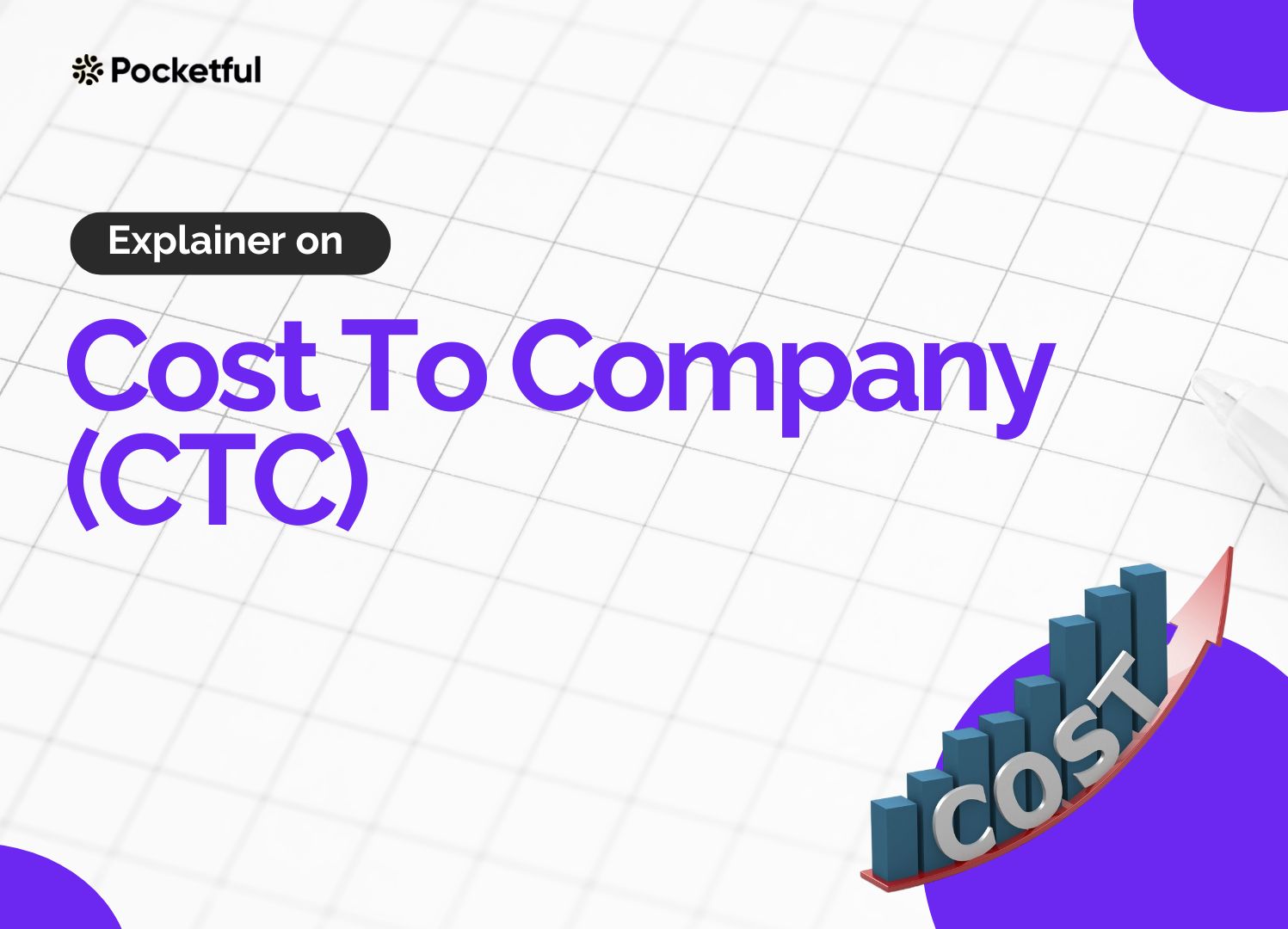| Type | Description | Contributor | Date |
|---|---|---|---|
| Post created | Pocketful Team | May-14-24 | |
| Heading Optimize | Nisha | Feb-18-25 | |
| Heading Optimize | Nisha | Feb-18-25 | |
| Heading Optimize | Nisha | Feb-18-25 |

- Blog
- breakdown of ctc
Breakdown of CTC: A Detailed Analysis

Did you know your take-home pay is only part of the picture? In India, CTC can be up to 30% more than your net salary. In this blog, we will explain why CTC is important and what it entails.
CTC – An Overview
CTC stands for Cost to Company. It refers to the total amount a company spends on an employee in a year, which includes the employee’s salary and all the benefits they receive. Benefits can include health insurance, housing allowances, and more.
To calculate CTC, you add the employee’s salary and benefits. For example, if an employee has a salary of INR 50,000 per month and the company pays INR 5,000 per month for his health insurance and other perks, then, the employee’s CTC would be INR 55,000 per month or INR 660,000 per year.
CTC differs from an employee’s net salary (the amount they take home). Taxes and other deductions are reduced from salary.
Breakdown of CTC

Basic Salary
This is the fixed amount of money an employee receives before any allowances or deductions. It forms the core of your take-home pay and is subject to income tax.
Allowances
These are monetary benefits provided by the company to help cover employee expenses. There are numerous allowances; some of the key allowances are:
1. House Rent Allowance (HRA)
HRA is a part of your CTC that helps offset the cost of renting a house. It is a monetary benefit, and under certain conditions, it is partially exempt from income tax.
Here is an explanation of HRA:
- HRA helps employees manage their rental accommodation expenses. The lowest of the following is the tax-exempt amount-
- HRA received from the employer.
- 50% of your base salary if you live in a metro city or 40% if you live in a non-metro city.
- Actual rent paid less than 10% of your base salary.
- However, there are certain conditions for exemption, which are as follows-
- You are required to be lodging in a rented space.
- You must have rent receipts as evidence of the payment.
- The landlord’s PAN card details might be needed (if rent exceeds INR 1 lakh annually).
Furthermore, HRA is unavailable if you live in your own house or company-provided accommodation.
2. Leave Travel Allowance (LTA)
LTA is another component of your CTC that falls under the allowance category. It is designed to partially reimburse your travel expenses incurred during your leave from work. Let us take a closer look at LTA:
- It aims to provide financial assistance for domestic travel during your vacation or leave period.
- LTA is exempt from income tax under certain conditions, allowing you to save on taxes.
- The exemption is available for two journeys in a block of four years. The lower of the following amount is exempted-
- Actual travel expenses incurred.
- LTA amount offered by your employer.
- Deemed travel expenses, which are calculated based on your salary and travel class.
- LTA covers your travel expenses for immediate family (spouse, dependent children, and sometimes dependent parents and siblings). The mode of travel can be bus, train, or economy airfare.
Generally, you must submit bills and travel documents to your employer to claim the LTA exemption.
Furthermore, LTA is meant for domestic travel within India. International travel expenses are not covered.
3. Conveyance Allowance
Conveyance Allowance, also known as transport allowance, is a part of your CTC that helps you cover the daily commuting expenses between your home and workplace and is partially exempt from income tax.
Let us take a closer look at the Conveyance Allowance:
- The main objective of conveyance allowance is to offset the cost of commuting to and from work.
- The amount of conveyance allowance that is exempt from income tax is limited. In India, the exempt amount is INR 1,600 per month or INR 19,200 per year.
- You do not need to submit any bills or receipts to claim the exemption for conveyance allowance.
4. Dearness Allowance (DA)
DA is a component of your CTC designed to address inflation. It is a monetary benefit provided by the government or some private sector employers to adjust your salary for rising living costs.
Let us have a quick overview of the dearness allowance:
- The purpose of DA is to compensate for inflation and help maintain purchasing power over time. As the cost of essential goods and services rises, DA helps bridge the gap and ensure your salary retains its value.
- The calculation of DA can vary depending on the entity providing it.
- In India, for government employees, DA is a percentage of their basic salary and is reviewed twice a year – January and July, depending on the Consumer Price Index (CPI).
- Also, private companies might calculate DA using their internal procedures or guidelines.
Read Also: Budget 2024: F&O Trading Gets More Expensive?
Employer Contribution
These are indirect benefits where the company pays on the employee’s behalf, which include:
1. Provident Fund (PF)
Provident Fund (PF) is a type of retirement savings plan that can be either optional or mandatory, depending on the structure and particular work circumstances. The purpose of PF is to provide financial security for employees after retirement.
Both employers and employees contribute a fixed percentage of the employee’s salary towards the provident fund. The contribution rates can differ by country and employment type.
An authorized financial institution or a government agency invests the contributions, and the employee can withdraw the collected funds under certain circumstances, such as medical emergencies. Additionally, the employee can withdraw the entire accumulated amount and the interest received upon retirement.
There are two types of provident funds.
- Employee Provident Fund (EPF) – A Provident Fund scheme for salaried individuals in India.
- Public Provident Fund (PPF) – A voluntary PF scheme provided by the Government of India and is open to all citizens.
2. Gratuity
An employer makes a one-time payment to an employee as a token of appreciation for their service, specifically after completing a long tenure with the company. It is a compulsory benefit under India’s Payment of Gratuity Act, 1972.
Individuals are eligible for gratuity if they have completed five or more years of continuous service with the same company.
The gratuity amount is calculated using the following formula:
Gratuity = Last drawn salary * (15/26) * number of completed years of service.
- The last drawn salary is your basic salary and dearness allowance.
- 15/26 is the factor that represents 15 days’ wages for each completed year of service.
- Number of completed years of service include any portion of the year over six months, regarded as a full year.
Additionally, there is a maximum limit on the gratuity payable. The cap is INR 20 lakh, which means you will earn a maximum of INR 20 Lakh even if the calculated gratuity amount is higher, and a part of the gratuity amount is taxable.
3. Employee State Insurance (ESI)
ESI is a social security program offered by the Indian government to a few employees and is managed by the ESIC (Employees’ State Insurance Corporation).
The main objective of ESI is to provide medical and financial assistance to employees and their dependents in case of sickness, temporary, or permanent disability because of employment, maternity, or death due to employment injury.
ESI applies to employees working in factories and other businesses registered under the ESI Act.
There is a minimum salary threshold for coverage. As of April 2024, employees earning up to INR 21,000 per month are generally covered under ESI.
Employers contribute 4.75%, and employees contribute 1.75% (for wages below INR 137 per day, employee contribution is nil.)
Also, employers must register their company with ESIC if they meet the eligibility criteria.
Read Also: Top Indicators Used By Intraday Traders In Scalping
Conclusion
To wrap up, a deep understanding of CTC is essential for anyone negotiating a job offer or evaluating a compensation package. Once you familiarise yourself with various components like allowances and employer contributions, you can get a clearer picture of the total value that you receive from your employer.
Frequently Asked Questions (FAQs)
What is a CTC?
CTC stands for the cost to the company. It is the total amount a company spends on an employee annually.
Why is understanding CTC important?
Knowing your CTC helps you understand the total value of your compensation package, which ultimately allows you to compare job offers more efficiently and negotiate your salary confidently.
What is the difference between CTC and take-home salary?
CTC is the total cost to the company, while your take-home salary is what you receive after taxes and other deductions from your CTC.
Does a higher CTC always mean a better job offer?
Not necessarily. A high base salary with fewer benefits might be better for some, while a lower base salary with great benefits might suit others.
Are there any taxes on CTC?
Taxes are levied on your take-home salary- a portion of your CTC after deductions.
Disclaimer
The securities, funds, and strategies discussed in this blog are provided for informational purposes only. They do not represent endorsements or recommendations. Investors should conduct their own research and seek professional advice before making any investment decisions.